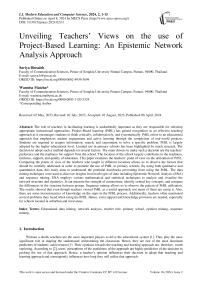Unveiling Teachers’ Views on the use of Project-Based Learning: An Epistemic Network Analysis Approach
Автор: Sariya Binsaleh, Wannisa Matcha
Журнал: International Journal of Modern Education and Computer Science @ijmecs
Статья в выпуске: 2 vol.16, 2024 года.
Бесплатный доступ
The role of teachers in facilitating learning is undoubtedly important as they are responsible for selecting appropriate instructional approaches. Project-Based learning (PrBL) has gained recognition as an effective teaching approach as it encourages students to think critically, collaboratively, and systematically. PrBL refers to an educational approach that emphasizes student engagement and active learning through the completion of real-world projects. Students are required to acquire information, search, and experiment to solve a specific problem. PrBL is largely adopted by the higher educational level. Limited use in primary schools has been highlighted by much research. The decision to adopt such a method depends on several factors. The main drivers to make such a decision are the teachers’ preference and the readiness for support from the school. The location of the school largely contributes to the readiness, facilities, support, and quality of education. This paper examines the teachers’ point of view on the utilization of PrBL. Comparing the points of view of the teachers who taught in different locations allows us to observe the factors that should be carefully addressed in order to promote the use of PrBL in primary schools. By using both qualitative and quantitative data, this study aims to understand the potential drawbacks preventing from using the PrBL. The data mining techniques were used to discover insights from both types of data including Epistemic Network Analysis (ENA) and sequence mining. ENA employs various mathematical and statistical techniques to analyze and visualize the network structure and dynamics. It can measure the strength of connections, identify central key concepts, and compare the differences in the structure between groups. Sequence mining allows us to observe the pattern of PrBL utilization. The results showed that even though teachers viewed PrBL as a useful approach, not many of them are using it. Also, there are some inconsistencies of knowledge on the steps in the PrBL process. Additionally, teachers often mentioned several problems they faced when using the PrBL. Hence, extra support and knowledge provision are needed, especially for schools located in suburban and rural areas.
Educational data mining, network analysis, teacher role, primary school, opinion mining, sequence mining
Короткий адрес: https://sciup.org/15019157
IDR: 15019157 | DOI: 10.5815/ijmecs.2024.02.01
Текст научной статьи Unveiling Teachers’ Views on the use of Project-Based Learning: An Epistemic Network Analysis Approach
Without a doubt, teachers are the most important players to drive the educational system [1]. They play the most significant role in shaping the studentsand orchestrating the classroom. Hence, they are one of the most dominant predictors of students’ achievement [1]. Their opinions towards the teaching and learning approach are, therefore, worth exploring. According to [2], users’ perceptions of the usefulness of the approach are highly predictive of the decision to prolong the use of that approach. Hence, a teacher’s opinion influences their decision to adopt that teaching and learning approach and consequently influences how long they will utilize that approach.
Project-Based Learning (PrBL) is one of the pedagogies that was used to cultivate active learning. This term is sometimes referred to as PBL, PjBL, or PrBL. In this paper, the common abbreviation PrBL is used throughout the paper. PrBL refers to the teaching and learning approach that was designed by involving students in undertaking their projects with peers to address specific real-world problems by seeking information, reviewing a potential solution, experimenting, and reporting or presenting the findings. PrBL offers numerous benefits such as promoting active engagement, fostering a deep understanding of the learning topics and their relevance to real-world situations, strengthening collaboration skills [7, 10], thinking skills and soft skills, and technical skills development [8, 9]. PrBL is often used at higher education levels. This is due to the fact that implementing PrBL is challenging and requires a certain understanding of how to apply it to make it effective. However, there is a lack of research exploring how well the teachers understand PrBL and its relevant process. With the insufficient understanding of the PrBL, it might yield to convey less effective learning and teaching. Yet not much research examines how well teachers understand and apply the PrBL. These are the motivations that drive this research study.
Besides the understanding of the teacher, the location of the schools also contributes to the readiness of facilities, teachers’ support, and quality of teaching. The schools located in the rural area have less readiness and less support for teachers and students. Consequently, these unfortunate factors contribute to the quality of graduates. These different qualities can be observed in the national examination. For instance, in Thailand, the Ordinary National Educational Test (ONET) is the test needed to be taken by high school students who wish to pursue their bachelor’s degree in higher educational institutions. The results of ONET revealed that those who studied in the provinces located on the border of Thailand such as Yala and Pattani obtained the lowest ONET score in Science, Mathematics, and English as compared to the average score of those who studied in the city such as Bangkok [26]. This has been raised as one of the urgent matters that require attention from the government in Thailand. In fact, improving the quality and equity in education has been devoted to as one of the sustainable development goals (SDG) of the United Nations (UN). Yet not much research examines the differences in terms of teachers’ opinions and their understanding of the use of PrBL based on the location of the school they teach, especially based on south-east Asia condition.
In addition to the lack of research examining how well teachers who teach at different school locations understand and perceive the PrBL, there is also a need to discuss the findings derived from the qualitative data collection. Much research explores the teaching quality and teachers’ opinions on the teaching approach by using self-report such as questionnaires and interviews to collect the data [3]. Thequestionnaires provide quantitative data which can be used to measure the range of perceptions, whereas an interview is considered qualitative data. Analyzing and synthesizing the knowledge contained within the qualitative data tends to be a challenge [4]. Much research uses qualitative data to support the findings derived from quantitative data rather than use it solely. This is due to the difficulty in processing, quantifying, and visualizing qualitative data [4, 5]. This research aims to fulfill that gap by demonstrating how research can utilize data mining technique such as sequence mining and Epistemic Network Analysis (ENA) to visualize the quantified qualitative data. Also, this research aims to examine the findings which can be observed from the aforementioned technique.
ENA is one of the data mining techniques that can be used to construct a network depicting the connections between explored elements. Previously, qualitative data were analyzed using the thematic analysis technique. Many thematic analyses resulted in a narration of the findings; hence, it was difficult to visualize, quantify, and synthesize the differences among the collected data. This research uses ENA to visualize the qualitative data, to unveil the differences in terms of teachers' points of view to discover the hidden insights in the collected data.
The following section will present the relevant research on PrBL, school location, and the Epistemic Network Analysis. Section 3 discusses the participant and data used in this study together with the corresponding analysis method. The results of this study will be presented in Section 4, followed by a discussion of the findings in Section 5. Some implications and limitations of the work will be presented in this section. This paper ended with the conclusion in Section 6.
2. Literature Review 2.1. Project-Based Learning (PrBL) and Teachers’ Role
This is the current teaching method that has been proven by much research as an effective approach [9, 15]. It is also referred to as a student-centered learning approach. PrBL, based on its nature, is considered a student-centered learning approach [7, 9, 16]. PrBL is among the most frequently used to facilitate learning. PrBL refers to a teaching and learning method allowing students to practice real-life skills systematically [6]. PrBL provides the opportunity for the students to have hands-on experience, learn how to solve problems on their own, explore how to design the work plan, learn how to lead as well as to follow, create higher-order thinking, and conduct self-evaluation [7-9]. In general, the PrBL process consists of six essential steps, including, preparation, project topic selection and design, project proposal development, project implementation, project presentation, and project evaluation. PrBL is used in teaching in the 21st century because a large number of research studies highlighted that PrBL encourages learners to utilize critical thinking [8], self-exploration and knowledge creation [9], work as a team [7], learn to work together as well as help and feedback of others [10]. These skills are considered the skills required for the development of the person in the 21st century.
By using PrBL, the role of a teacher has been shifted from being the main conductor of the classroom to becoming a trainer or coach to the students. That is, teachers were previously leading knowledge providers for students, now teachers’ main tasks are to guide, facilitate and coach the students. Ultimately, teachers have to find ways to support and enable the students to learn and create knowledge by themselves.
Even though PrBL can promote the higher order of thinking and contribute to several benefits to students, the application of PrBL in school is limited [16]. PrBL was most frequently used in higher education, especially, for the final year’s project. Much is not known regarding the application of PrBL in primary and secondary schools. This is partially because implementing the PrBL is challenging and time-consuming. Teachers need to carefully design the learning process; they need to provide instruction that could guide the development of the project. Much is not known in terms of how well teachers understand the process of Pr.BL This research is, therefore, looking into this research gap. Hence, this research question (RQ) is formulated to guide this research:
RQ1: How well do the teachers understand the Project-Based Learning process?
-
2.2. School locations
-
2.3 Epistemic Network Analysis
As discussed thus far, the teacher’s role to facilitate learning is important. The quality of teaching and learning is influenced by several factors such as the quality of the teaching approach, the social economy, the support from the government and school, the readiness of facilities and utilities, and many more. The location of the school is largely contributed to the support and readiness relevant to the learning resources, facilities, utilities, and quality. It is often reported in the research that the location and environment of the school contribute to the teaching approach. For example, Kormos [19] examine the perception of web-based classroom technologies of teachers who teach at school located in urban, suburban, and rural area. He found that in rural areas, teachers had different opinions on the usage and effectiveness of web-based technologies and software as compared to the other groups. Also, the support from management parties and schools will influence teachers’ decisions to use a particular approach. For instance, the same research study revealed that budget and support is the main issue concerned by teachers in rural area [19]. Additionally, city schools may have access to a wider range of resources, up-to-date technology, more specialized teachers, and more opportunities for extracurricular activities. These factors can contribute to higher levels of student engagement and better academic outcomes.
In many cases, students attending schools in rural areas are more likely to come from low-income families, hence, lower socio-economic as compared to those who study in the city area. The socio-economic status of the student is often reported to be one of the factors that contribute to learning achievement. Students from low-income families may face a range of challenges that can affect their academic performance, such as a lack of access to resources, lower levels of parental involvement, and few learning options and activities, which can contribute to lower levels of academic achievement. In addition to these factors, the location of a school can also impacts the academic programs and resources that are available to students. For example, rural schools may have limited access to specialized courses or extracurricular activities, which can limit students' opportunities to explore their interests and develop new skills. city schools, on the other hand, may have a wider range of programs and resources available, which can help to engage students and support their academic growth. Hence, PrBL comes into practice. As PrBL can be adapted to suit the situation of the learners. Teachers can design the PrBL by considering the real-life situation of the student. Yet not many schools and teachers utilize the PrBL.
Perception of usefulness is often used in technology-enhanced education. Not much exploration of the perception of the usefulness in education where technology is not fundamental such as in schools located in non-technology readiness. Hence, this research aims to examine if the perception of the usefulness of PrBL is affecting the actual use of PrBL and how teachers who teach in different locations (i.e., teaching at schools located in rural, suburban, and city) view the application of PrBL. Hence the following RQ was formulated:
RQ2: Were there any differences in teachers’ opinions based on the location of the school they teach?
Qualitative data is often used when one wants to understand the opinion about something. It refers to non-numerical data. In research, qualitative data can capture the participants’ opinions or ideas about a research topic. The advantage of collecting qualitative data is that it allows the participants to freely open up their ideas about the discussed topic. Similarly, in educational research, qualitative data were often collected, especially, when the researchers want to examine the teachers’ opinions.
However, making sense of the qualitative data is quite challenging. Hence, the qualitative data were often used together with the quantitative (i.e., numerical and quantifiable data). This is referred to as a mixed method in research. Among the techniques used to analyze the qualitative data are discourse analysis and thematic analysis.
Epistemic Network Analysis (ENA) is one of the network analysis techniques. It was developed based on the epistemology theory. ENA can be used to analyze both quantitative and qualitative data [22]. For instance, Wakimoto et al., [23] used ENA to visualize the discourse between student and teacher. Fougt et al., [24] analyzed the students’ written assignments by using the ENA. As demonstrated by much research mentioned earlier, ENA enables researchers to observe the insights which contributed to the conversion from different stakeholders such as teachers, students, and others.
Although ENA can provide insights into qualitative data, not much research utilizes such method. Hence, this research will implement the ENA to help in exploring the teachers’ opinions on the use of PrBL.
3. Method
This research used both qualitative and quantitative data. The quantitative data were collected by using the interview. The quantitative data were collected by using a set of questionnaires. The following section explains the research method in detail.
-
3.1. Data and Participants
The three southern border provinces of Thailand (i.e., Pattani, Yala, and Narathiwat) are considered vulnerable areas due to the conflict that arise in 2004. Since then, the development in this area has been worrisome. The education systems in this area are unique as compared to the other part of Thailand. That is, several schools are offering to teach both general academic knowledge and Islamic knowledge. Hence, there are many private schools registered in these three provinces. Also, the majority of the population in this area are Muslim and use their native language as a means of communication. There are 76 registered private Islamic schools in 2023 located in the three southern provinces that are taught from grade 1 to grade 6. They offered to teach both the ordinary and religious curriculums. Out of 76 schools, 24 schools are located in Yala, 28 schools in Pattani, and 24 schools in Narathiwat.
The quantitative data were collected by using a set of questionnaires. The questionnaire consisted of three parts including:
-
• Part 1 aims to collect personal information including school location, age, years of teaching experience, and subject taught at school. The participants were also asked if they know what PrBL is and if they use it in the class.
-
• Part 2 aims to test the understanding of the PrBL process. Participants were asked to sort out the steps of the PrBL process. They are no restrictions in ordering these steps. For instance, if participants think that the defined steps should be conducted at the same time, they can sort them in the same order. The steps that teachers were asked to order are presented in Table 1.
-
• Part 3 aims to collect data about the participants’ perception of the use of PrBL. Participants were asked how much they agree with the following items (refer to Table 2) by using Likert Scale (1 strongly disagree – 5 strongly agree):
-
3.2. Quantitative Data Analysis
Table 1. The questionnaire used in this study
|
Step |
Definition of the steps |
|
Analyse |
Analysis and Synthesis |
|
Define |
Define problem and scope |
|
Define |
Define objective and hypothesis |
|
Experiment |
Experimentation |
|
Finding |
Finding Solution |
|
Preparation |
Preparation |
|
Presentation |
Presentation |
|
Review |
Literature review |
Table 2. The questionnaire used in this study
|
No. |
Code |
Questions |
|
1 |
Academic achievement |
PrBL contributes to student achievement the most |
|
2 |
Actively engage |
PrBL makes students more active in their studies and always seek knowledge |
|
3 |
Attentive to learning |
PrBL makes students more attentive to learning |
|
4 |
Committed to use |
You are committed to using the PrBL in teaching |
|
5 |
Develop higher thinking |
PrBL helps students to develop a higher order of thinking |
|
6 |
Develop skills |
PrBL helps students to develop the skills in planning, leading and collaborating |
|
7 |
Enjoy learning |
PrBL makes learning more enjoyable for students |
|
8 |
Highly useful |
PrBL is very useful in teaching and learning. |
|
9 |
Increase awareness |
PrBL increases the potential for awareness. Students are elevated when they engage in meaningful problem-solving activities. |
|
10 |
Learning problem solving |
PrBL allows students to learn how to solve problems by themselves |
|
11 |
Participate in learning |
PrBL makes students more involved in class |
The questionnaires were distributed online. Teachers were first informed of their right to answer the questionnaires and they are informed that the information will be kept confidential. Overall, there are 105 teachers from three provinces who volunteer to answer the questionnaires. However, due to some incomplete responses, only 96 responses were used in this study.
The qualitative data were collected by using the semi-structured interview at a separate session. The semistructured interview is described as the use of open-ended questions to guide the discussed topic, rather than guide the answer [20]. Four questions were used in this study, including, previous teaching approach/preparation; knowledge of students’ learning; PrBL experience; perception of PrBL. To interview the teachers, the samples were selected purposively (purposive sampling). At least, two schools from each province were asked to participate in the interview section to collect information on teachers’ opinions toward PrBL and its usefulness. As a result, there are four to five teachers from two schools located in each province were contacted and participated in this study. Hence, a total number of 29 teachers participated in the interview session.
Overall, the questionnaires wereas analyzed by using descriptive statistics including mean, median, and quartile. The boxplot was used as it can present overall information. The data collected to observe the teachers’ knowledge of PrBL steps and processes (Part 2 of the questionnaire) was analyzed by using sequence mining.
Sequence mining is a data mining technique that can be used to automate discovering the pattern of sequencing data. In this study, the TraMineR R package was used. TraMineR can use to visualize the state of an event that is defined by order. It is one of the most frequently used data mining techniques in the field of social science as well as education. Many researchers applied TraMineR to discover the learning pattern of log data recorded by the Learning Management System.
In this study the sequence mining was created based on the teachers’ answers about the steps in the PrBL process. That is, teachers were asked to state which steps the identified process (refer to Table 1) should be done. Then, the reshape algorithm was used to formulate the answer to the format accepted by TraMineR R package. There are eight distinct steps, hence, these steps are considered as the states and were used as an input to formulation the sequences.
A state distribution plot was used to visualize the sequence of the cross-sectional state frequencies by position (i.e., order of the step). That is, the state distribution plot will be used to observe the ordering of the PrBL steps that the teachers were asked to complete as in part 2 of the questionnaire. This information reflects how well the teachers understand the PrBL process, hence, answering the RQ1: How well do the teachers understand the Project-Based Learning process?
3.3. Qualitative Data Analysis
4. Result4.1. RQ1: How well do the teachers understand the Project-Based Learning process?
The interviews were transcribed into text messages. As a result, 112 conversations from 29 teachers were recorded and transcribed. The thematic analysis was initially applied to identify the general theme mentioned by teachers during the interview. The main idea of thematic analysis is to organize and simplify the meaning underlying the sentences of the interviewees into a manageable set of codes [20]. The data were thematically analyzed by two independent coders. Later, the results from the two coders were compared. The conflicted results were discussed between the two researchers to reach a mutual agreement. Based on the final agreements from two independent coders, the data were thematically coded as presented in Table 3.
Table 3. The educational perspectives and descriptions
|
Theme and code |
Description |
|
|
Time |
Prior.PrBL |
Interviewee mentioned that the discussed topic happened before application of PrBL |
|
General |
Interviewee did not specify the time relevant to the discussion |
|
|
After.PrBL |
Interviewee mentioned that the discussed topic happened after application of PrBL |
|
|
Stakeholders |
Student |
Interviewee referred to students during the discussion |
|
Teacher |
Interviewee referred to teacher during the discussion |
|
|
Guardian |
Interviewee referred to guardian during the discussion |
|
|
Mng.Party |
Interviewee referred to the management body or school during the discussion |
|
|
Effects |
Problem |
Interviewee mentioned about problem that he/she has faced |
|
Improve |
Interviewee mentioned about benefits or improvement that he/she has observed |
|
|
Support |
Support |
Interviewee mentioned about the support from the school such as the computer and other equipment |
|
Learning Experience |
Engagement |
Interviewee mentioned about the learning engagement |
|
Excitement |
Interviewee mentioned about the feeling such as exciting, happy, or boresome |
|
|
Boresome |
Interviewee mentioned about the feeling boresome |
|
|
Satisfaction |
Interviewee mentioned about the feeling of satisfaction |
|
|
Performance |
Interviewee mentioned about the learning performance, score, or grade |
|
|
Confident |
Interviewee mentioned about the confidence in teaching and learning |
|
|
Participation |
Interviewee mentioned about the participation in classroom |
|
|
Acceleration |
Interviewee mentioned about the improvement or accelerate in terms of skills |
|
|
Analytics |
Interviewee mentioned about analytical skill |
|
|
Creativity |
Interviewee mentioned about the skills in creativity |
|
|
Knowledge |
Interviewee mentioned about gaining knowledge |
|
|
Prior Knowledge |
Interviewee mentioned about the prior knowledge before the lesson |
|
|
Family.Situation |
Interviewee mentioned about the family situation or problem in the family |
|
|
Preparation |
Roles |
Interviewee mentioned about the roles of the stakeholders |
|
Time spent |
Interviewee mentioned about the time spending |
|
|
PrBL |
Interviewee mentioned about the Project-Based Learning |
|
|
Process |
Interviewee mentioned about the process in preparation for teaching and learning |
|
|
Approach |
Interviewee mentioned about the approach or pedagogy used |
|
|
Tools |
Interviewee mentioned about the tools and media used to mediate the teaching and learning |
|
ENA is then applied to the coded data. ENA is considered a data mining technique based on the graph and network analytic method. It visualizes the relationship of the elements by measuring the co-occurrence of coded items [22]. That is, the ENA will calculate based on how often the identified code is mentioned by each interviewee from each conversation. Hence, ENA portrays the structure of a conversation. The coded items (as presented in Table 1.) refer to ‘node’ in network analysis [22]. The size of the nodes depends on how many times the node was mentioned by the interviewees. Therefore, the node will be bigger if it was frequently emphasized by the interviewee. Therefore, it can be inferred that the particular items (coded data) were identified as an important factor in learning. The line that connects between nodes depicts the connection or relationship between the coded items. The ticker the line is, the stronger the connection between the node become [22]. That is, the two coded items were frequently mentioned by the interviewees together in the same conversation. In sum, the opinion of teachers can be automatically visualized by using ENA. Hence, it allows researchers to observe the opinion of teachers and easily inferred the important factors from the interview.
Also, ENA allows us to observe the differences between the two networks. Unlike other graph analysis techniques, ENA projects the nodes and lines calculated from the same dataset in the same ENA space. Hence, a comparison can be done by subtracting the graph [22]. Therefore, the different opinions of the teachers who teach a different subject and who teach at different locations of school can be observed. It also allows for statistical measurement based on the projected location of the mean nodes in the ENA space. Hence, ENA enables the research to observe the significant differences between the two groups of opinions.
The following sections present the results according to the research questions defined in Section 2.
A total number of 96 responses after excluding the uncompleted responses were included in this study. The majority of participants are female (87.5%). The average teaching experience was about 9.24 years (median (Q1, Q3) = 10 (5, 12)). 42.71% teach Grades 1-3 while 43.75% teach the upper level (Grades 4-6) and about 13.54% teach both levels. About 58.33% (56 teachers) teach in a school located in the city, 26.04% (25 teachers) teach in a school located in the suburban area and 15.63 (15 teachers) teach in the schools located in the rural area.
When asked if the participants know what PrBL is, the majority of teachers who participated in this study answered ‘yes’ (64.58%). The majority of the teachers (40 out of 56 teachers) who teach at the school located in the city know the PrBL 15 out of 25 teachers who teach in a suburban know PrBL and less than half of the teachers (7 out of 15 teachers) who teach in the rural area know PrBL.
When asked if they used the PrBL in their classes, the majority reported not using the PrBL (63.54%). Of 40 teachers who teach in the city and know what PrBL is, only 23 teachers reported using PrBL in their classrooms. Out of 15 who teach in the suburban area and know PrBL, 8 teachers actually use PrBL to guide their classes. Lastly, of 7 teachers who teach in the rural area, only 4 used PrBL. The answer based on the location of the schools that the teachers taught is presented in Fig. 1.
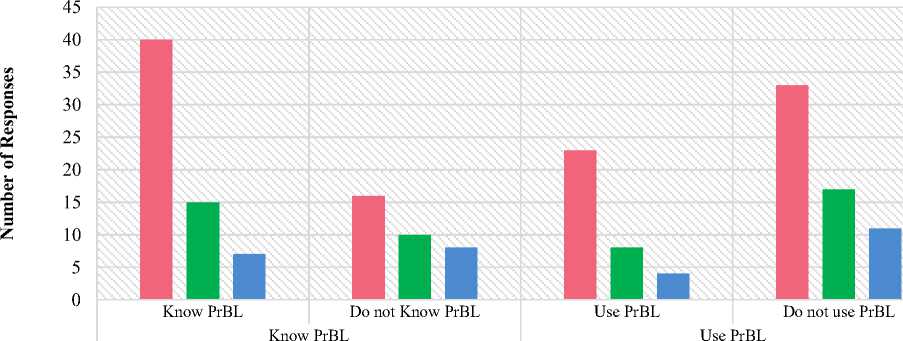
■ City 40 16 23 33
■ Sub-urban 15 10 8 17
■Rural 7 8 4 11
Fig. 1. A total number of responses on their knowledge of PrBL and if they use PrBL in the classroom.
In total, only 35 teachers stated that they used the PrBL as a medium of instruction in their classes. In terms of the subject’s application, Language has been reported as the highest PrBL usage, and Sciences and Technology are the second highest followed by social sciences-related subjects as shown in Fig. 2.
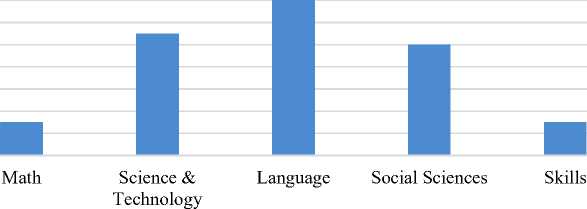
Fig. 2. Subjects that PrBL has been applied to orchestrate the learning.
When exploring in terms of how well they know the PrBL by asking the teachers to order the steps in PrBL, 35 of those who report using PrBL in their class report different patterns of steps as presented in Fig.3. The process of producing the sequence mining (Fig.3.) presented in Section 3.2.2. The majority of the teachers define a preparation (blue color) and define (green color) as the first step. Experimentation is usually allocated as the middle step (steps 4-6).
Analysis is usually allocated after the experimentation and presentation is often defined as the final step in the process of PrBL. Fig. 4. presents the sequence of PrBL defined by the teachers based on the location of the school they teach. Overall, the pattern of steps definition is not clear. Many diversities can be observed in the sequence patterns. Teachers from the schools located in the city and rural areas stated the preparation as the first step, meanwhile, teachers from the suburban school stated the defining step as the first step of the PrBL process. Note that some teachers from both city and suburbanbased schools stated the preparation as the middle step.
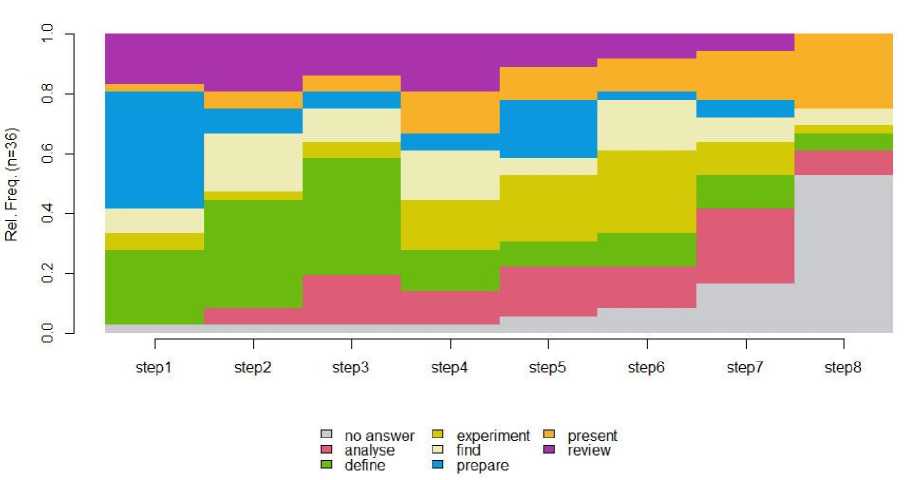
Fig. 3. The state distribution of learning steps as sorted by participants.

I I I I I I I I stepl step2 step3 step4 step5 step6 step? step8
(a) Sub-urban
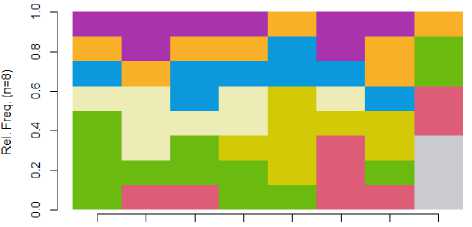
stepl step2 step3 step4 step5 step6 step? step8
(b) Sub-urban
(a) City
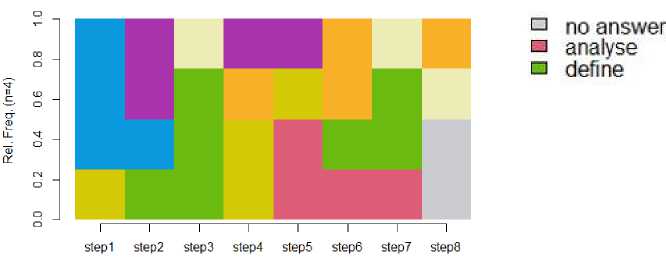
(c) Rural
Fig. 4. The state distribution of learning steps based on the school location.
о experiment о present
□ find ■ review о prepare
-
4.2. RQ2: Were there any differences in teacher’s opinions based on the location of the school they teach?
-
4.2.1 Questionnaire
Exploration of the differences in terms of teachers’ opinions on the PrBL was gathered by using both quantitative and qualitative data. The following presents their opinion based on the type of data collected.
Fig. 5 presents the boxplots of the perceived usefulness of PrBL. The lowest edge of the box indicates the first quartile of the score obtained from the 5-item Likert scale questionnaire. The upper edge of the box indicates the third quartile of the score, and the line in the middle indicates the median score. The dot indicates the outliers.

1 -
2-


Fig. 5. Response from teachers regarding the perceived usefulness of the PrBL based on location of the schools.

Overall, the teachers who teach in the city-based schools show overall higher scores in all measuring items for the usefulness of the PrBL as compared to the other two groups. They score approximately 4 out of 5. Similarly, teachers from the suburban area often report high scores on the usefulness of the PrBL (approximately 4 over 5). Whereas teachers from rural area schools reported the lowest score in most of the items. That is, the teachers from rural area schools have suggestively different opinions regarding the usefulness of the PrBL. For instance, rural area schoolteachers rated neutral (approximately 3 over 5) when asking if the PrBL contributes to academic achievement, active engagement, attention to learning, development of skills and higher order of thinking, enjoyment of learning highly useful and developing problem-solving skills. Only the question asking if PrBL makes students more involved in class, rated 4 over 5.
-
4.2.2 Interview
The overall results obtained from the application of the thematic analysis showed that five important themes were mentioned by interviewees when they were asked about previous teaching approaches/preparation; knowledge of students’ learning; PrBL experience; perception of PrBL. These five themes include time, stakeholders, effects, learning experiences, and teachers’ preparation for the classroom.
Stakeholders were often mentioned by the teachers. Based on the interviews, four stakeholders in education systems were mentioned including students, teachers, guardians such as parents or grandparents, and management parties such as the headmaster of the schools, manager of the schools, or mentioned as a school in the overall picture.
Effects refer to the impact or results of applying or not applying the PrBL. So, effects can be divided into two codes including problem in teaching, learning, and management ( Problem ) and improvement or enhancement in teaching, learning, and management ( Improve ). Support refers to the provision that was offered or necessary provision that should be provided by the school ( Support ).
Learning experiences refer to the targeted learning experiences that are usually mentioned by the educational theory as an outcome, or influent factors of the learning. The mentioned learning experiences which were observed from the interview included learning engagement, excitement, boresome, satisfaction, performance, confidence, participation, acceleration, analytics, creativity, knowledge, prior knowledge, and family situation.
Preparation refers to the process of preparing for the class. Both teachers and students need to prepare for the class. When teachers were asked how they prepare for the class, the most common themes mentioned by teachers included roles of teachers or students ( Roles ), time spent in preparation ( Timespent ), PrBL, step-by-step preparation for the class ( Process ), approach or pedagogy planned to use ( Approach ) and tools, equipment, or media used to facilitate the learning ( Tools ).
Fig. 6 to 8 illustrates the overall network of the interviewed conversations based on the geographic location of the schools, namely, urban, suburban, and rural areas, respectively. Different colors were used to differentiate the structure of the networks based on each geographic location, that is, blue color refers to the network of conversation retrieved from the teachers who teach in the schools located in the city area. Red color represents the opinions of teachers who teach in the schools located in the rural area and purple color represents those who teach in the rural area schools.
Improve, Students, and Teacher. When examining closer to the connection that construct this network, it is clear that there were strong relationships between After.PrBL-Improve and Improve - Student . This indicated that based on teachers’ opinions, after using the PrBL in their classroom, they observe the students’ learning improvement.
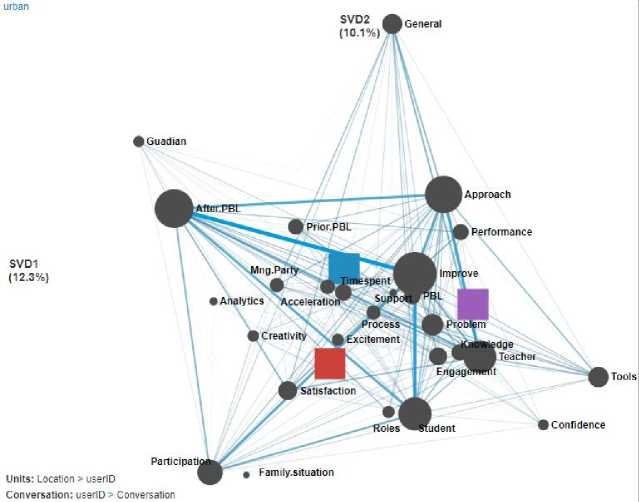
Fig. 6. Structure of the interview conversations given by the teachers who teach in a school located in city area.
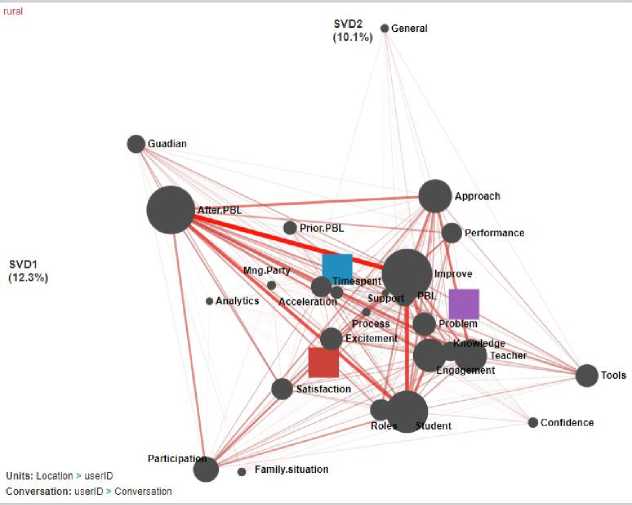
Fig. 7. Structure of the interview conversations given by the teachers who teach in a school located in rural area.
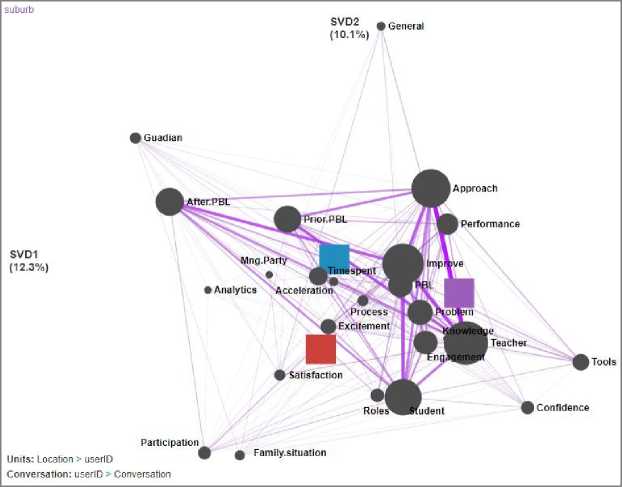
Fig. 8. Structure of the interview conversations given by the teachers who teach in a school located in suburban area.
Also, teachers often mentioned that by using the PrBL, they were a change in the approach they used for teaching as can be visibly observed through the connection between Ater.PrBL-Approach and Approach-Teacher . There was a direct connection between After.PrBL and Student indicated that the use of PrBL had a direct influence on the students.
In Fig. 6 and 7, the connection between After.PrBL and Participation and also Participation and Satisfaction were much clearer as compared to Fig. 8. This reflected that teachers who teach in schools located in the city and rural areas pointed out the same opinion, that is, after using the PrBL , there was an increased level of student participation in the activities. This point of view was not much mentioned by the teacher who teaches in a school located in the suburban area (Fig. 8).
Using a comparative function of the ENA offers a clearer insight into these differences as presented in Fig. 9-11. The dominant color represents a stronger connection between nodes retrieved from the opinions of the teachers who teach in the schools located in the respective locations based on the color codes explained earlier in this section.
Comparing the opinion given by teachers who teach in the school located in city areas and suburban areas revealed that teachers from the school located in rural areas often mentioned the students’ engagement after using the PrBL ( After . PrBL - Student ; Student - Engagement ; and Engagement - Improve ). Also, they often mentioned the students’ engagement together with the excitement ( Engagement - Excitement ). Note that the teachers from the rural areas often highlighted the role of guardians such as parents and it linked to the improvement as well as problems.
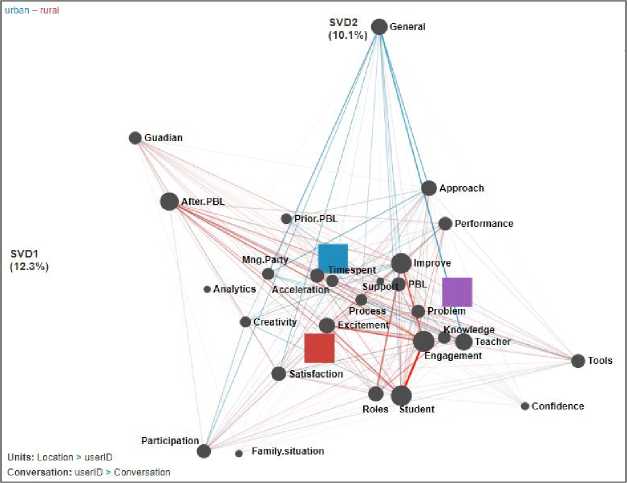
Fig. 9. A comparative Structure of the interview conversations between the teachers who teach in a school located in city area and rural area.
Comparing the opinions of teachers who teach in schools located in city and suburban areas showed that teachers in suburban areas pointed out the problems prior to the application of PrBL much more frequently compared to the teachers who teach in city areas. As shown in Fig. 10, the stronger connections between Prior.PrBL - Problem were much more visible in the purple line. They mentioned that before the use of PrBL, students had some trouble being engaged in the class activities ( Problem - Engagement ) and learning performance ( Problem - Performance ). For teachers themselves, prior to the application of PrBL, they often face a challenge in the teaching approach as observed by the purple line connecting the Teacher - Approach and Teacher - Problem.

Fig. 10. A comparative Structure of the interview conversations between the teachers who teach in a school located in city area and suburban area.
Comparing the opinion given by teachers who teach in the school located in rural areas and suburban areas showed that teachers from the school located in rural areas often mentioned the effects of PrBL much more often than the teachers who teach in the suburban area as presented by several red lines connected to the After . PrBL and Improve. The teachers who teach in the schools located in the suburban area highlighted the problems they face prior to the application of PrBL much more often as demonstrated by the connection between Prior.PrBL - Teacher; Prior.PrBL-Approach and Teacher-Approach. Meanwhile, teachers from the rural area often mentioned about guardian’s role together with improvement and problems.
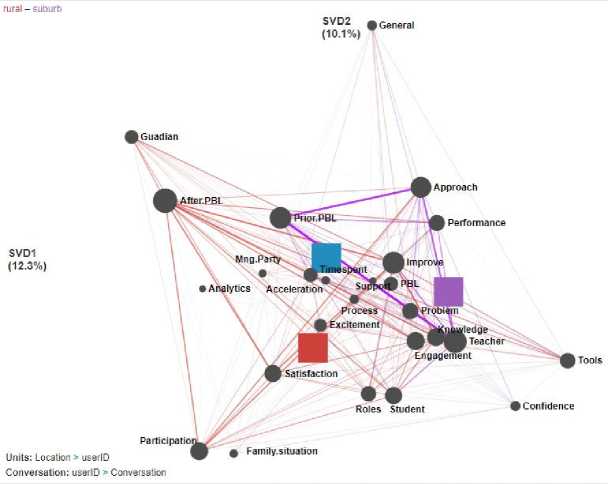
Fig. 11. A comparative Structure of the interview conversations between the teachers who teach in a school located in suburban and rural area.
5. Discussion
PrBL does not necessarily require technology to support the process, hence, it is one of the suitable approaches to be used at any schools regardless of the technological readiness of the school. However, the role of teachers plays much more important when implementing the PrBL. The results obtained from the questionnaire showed that there is inconsistency in understanding the steps of the PrBL. Many teachers reported no knowledge of the use of PrBL. In addition to that, those who applied PrBL in class showed inconsistency in the application steps. This is an important matter that requires attention from the higher management parties as well as the government. Yet, the majority of the teachers showed a positive view on its benefits to the students.
Based on the exploration of the teachers’ opinions when they were asked about the PrBL, showed that teachers who taught in schools located in different geographic locations faced different kinds of challenges in teaching the students.
Also, all teachers reported being satisfied with the application of PrBL. This is a positive sign. As mentioned earlier, the user’s satisfaction with any particular method, approach, or system will predict the future of adopting that particular method [2, 18]. Since the PrBL has been highlighted as having positive advantages to both students and teachers, the feeling of satisfaction will most likely result in the adoption of PrBL in the future. Hence, it can be expected that students will benefit from the application of such a method. However, much research is needed in order to confirm this assumption.
The comparison of teachers’ opinions by using ENA revealed several interesting points. Firstly, teachers who teach in the suburban area often pointed out the problems they faced and the previous teaching method they used. This is important to the education system and stakeholders who are in charge of the development of the teachers. Perhaps, more training and support are needed for the schools located in the suburban areas as they often pointed out the challenges they faced. Secondly, students who enrolled in the school located in this area have been observed by their teachers as having challenges in being engaged in class activities. The use of teaching methods that encourage the students’ participation like PrBL is suitable to be applied by the teachers who teach at the schools located in these areas.
The results from the questionnaires and interviews showed a slightly different view. The questionnaires reveal that teachers from the rural area schools have a slightly different perspective of the PrBL. This is similar to the study of Kormos [19]. That is teachers in the rural areas rated neutral on the usefulness of the PrBL. Meanwhile, the teachers who teach in the city or suburban area rated the benefits of PrBL higher than those from the rural. The interview results suggested that teachers who teach in the schools located in the city area mentioned the PrBL and its effects and improvement. While teachers from the suburban and rural areas often highlight problems. Especially for those from the rural area, the role of guardians has been mentioned several times. This is due to the socio-economy of the students. Thus, the lower socio-economy, parents often have to work in a different location and left the children under the care of their grandparents. Hence, these students often lack support from their guardians.
5.1. Limitation and Suggestion for Future Work
5.2. Implications
6. Conclusion
This research only focused on the private Islamic schools located in the three southern border provinces of Thailand. Private Islamic schools have a unique curriculum. That is, students need to learn both ordinary subjects as guided by the Thai Education Office, and on top of that, they need to spare some time to learn religious subjects. Hence, it might be a challenge for teachers who teach in these schools. Also, the number of participants who answered the questionnaires are not balanced among the three areas and only 29 teachers participated in the interview. Increasing the number of teachers will increase the robustness of these findings. This paper is only focused on the teachers’ perceptions. Adding more insights from other stakeholders will be very beneficial to this study. Lastly, some techniques like Natural Language Processing (NLP) can automate the coding process. This will make the coding process become much easier and faster, especially, for the large volume of dataset.
The findings of this research suggested that PrBL is one of the teaching approaches that can be used to facilitate learning. Even though most of the teachers viewed this method as an effective approach and realized many benefits to the student, but only a few of them actually applied it in their classroom. When exploring in terms of how well they know the PrBL steps, the sequence mining pattern showed inconsistency which suggested a lack of knowledge. Hence, educational parties who are in charge of the development of teachers and education might need to pay attention to this matter, especially for the teachers who teach in the schools located in the suburban areas as many teachers mentioned the problems, they faced prior to the application of PrBL as well as those who teach in the rural areas. Also, relevant educational parties might need to encourage and promote the use of PrBL as it has been viewed as an effective learning approach.
Another important implication that can be observed from this research is the application of network analytics such as ENA to visualize the qualitative data. ENA enables us to observe the structure of spoken conversations. Applying the ENA together with the thematic analysis allows the researchers to compare the different points of view from different groups of participants. Hence, insights into learning can be derived.
This paper presented a study on teachers’ opinions on the use of PrBL by using semi-structured interviews to guide the discussion as well as the questionnaires to gather the information. The questionnaires revealed even though teachers realised the benefit they may get from the application of PrBL, more than half of the samples did not know and nor did they use the PrBL. The sequence mining revealed that the lack of knowledge in PrBL is possibly one of the factors contributing to the decision to use it in their classroom. In addition to that, the main technological insights derived from this study are the use of data mining to quantify qualitative data. Previously, the qualitative data was analyzed by using thematic or discourse analysis which resulted in the categorization of the content into the corresponding theme. This study presented the extension to such a method by applying the ENA to visualize the opinion of the teachers, hence, bringing the conversion into graphs. By using this method, the qualitative data is quantified which allows the researchers to observe and compare the opinions of teachers across different groups. That is, in this study, the teachers were grouped based on their school locations. Such a method presented a new contribution to the field. That is, teachers view the PrBL as having advantages and positive impacts on both teachers and students. However, teachers who teach at schools located in suburban and rural areas often pointed out the challenges they faced prior to the application of the PrBL. These findings suggested that there is need for the management parties to support the schools, particularly those located in the suburban and rural areas to enable them to access the technology and knowledge on how to apply the PrBL to enhance learning.
Acknowledgment
We would like to thank Dr. Muazzan Binsaleh from Prince of Songkla University Pattani Campus, Thailand for his contribution on the data collection process during the interview.
Список литературы Unveiling Teachers’ Views on the use of Project-Based Learning: An Epistemic Network Analysis Approach
- Darling-Hammond, L. (2003). Keeping good teachers: Why it matters, what leaders can do. Educational leadership, 60(8), 6-13.
- Alonso, R. R., Plaza, I. R., & Orfali, C. H. (2019). Barriers in teacher perception about the use of technology for evaluation in Higher Education. Digital Education Review, (35), 170-185.
- Van Hattum-Janssen, N., & Mesquita, D. (2011). Teacher perception of professional skills in a project-led engineering semester. European Journal of Engineering Education, 36(5), 461-472.
- De Casterlé, B. D., Gastmans, C., Bryon, E., & Denier, Y. (2012). QUAGOL: A guide for qualitative data analysis. International journal of nursing studies, 49(3), 360-371.
- Noble, H., & Smith, J. (2014). Qualitative data analysis: a practical example. Evidence-Based Nursing, 17(1), 2-3.
- Kokotsaki, D., Menzies, V., & Wiggins, A. (2016). Project-based learning: A review of the literature. Improving schools, 19(3), 267-277.
- Thomas, J.W. (2000). A review of research on project-based learning. San Rafael, CA: Autodesk. http://web.archive.org/web/20030812124529/www.k12reform.org/foundation/PrBL/research/
- Terada, Y. (2021, February 21). New Research Makes a Powerful Case for PRBL. Edutopia. https://www.edutopia.org/article/new-research-makes-powerful-case-PrBL
- Bell, S. (2010). Project-based learning for the 21st century: Skills for the future. The clearing house, 83(2), 39-43.
- George Lucas Educational Foundation. (2001, November 1). Project-based learning research. Edutopia. www.edutopia.org
- Syakur, A., Junining, E., & Sabat, Y. (2020). The Implementation of Project Based Learning (PRBL) Model Towards the Result Student’s TOEFL in 7th semester of Brawijaya University. Journal of Development Research, 4(1), 41-46.
- Thomas, J.W. (1998). Project-based learning: Overview. Novato, CA: Buck Institute for Education.
- Bransford, J. D., Brown, A. L., & Cocking, R. R. (2000). How people learn (Vol. 11). Washington, DC: National academy press.
- Armstrong, P. (2010). Bloom’s Taxonomy. Vanderbilt University Center for Teaching. Retrieved [15 December, 2021] from https://cft.vanderbilt.edu/guides-sub-pages/blooms-taxonomy/.
- Smart, K. L., & Csapo, N. (2007). Learning by doing: Engaging students through learner-centered activities. Business Communication Quarterly, 70(4), 451-457.
- Sanchez-Romero, J. L., Jimeno-Morenilla, A., Pertegal-Felices, M. L., & Mora-Mora, H. (2019). Design and application of Project-based Learning Methodologies for small groups within Computer Fundamentals subjects. IEEE Access, 7, 12456-12466.
- Chintalapati, N., & Daruri, V. S. K. (2017). Examining the use of YouTube as a Learning Resource in higher education: Scale development and validation of TAM model. Telematics and Informatics, 34(6), 853-860.
- Waheed, M., & Jam, F. A. (2010). Teacher's intention to accept online education: Extended TAM model. Interdisciplinary Journal of Contemporary Research in Business, 2(5), 330-344.
- Kormos, E. M. (2018). The unseen digital divide: Urban, suburban, and rural teacher use and perceptions of web-based classroom technologies. Computers in the Schools, 35(1), 19-31.
- Peel, K. L. (2020). A beginner's guide to applied educational research using thematic analysis. Practical Assessment, Research, and Evaluation, 25(1), 2.
- Yeung, M. W., & Yau, A. H. (2021). A thematic analysis of higher education students’ perceptions of online learning in Hong Kong under COVID-19: Challenges, strategies and support. Education and Information Technologies, 1-28.
- Shaffer, D. W., Collier, W., & Ruis, A. R. (2016). A tutorial on epistemic network analysis: Analyzing the structure of connections in cognitive, social, and interaction data. Journal of Learning Analytics, 3(3), 9–45.
- Wakimoto, T., Sasaki, H., Hirayama, R., Mochizuki, T., Eagan, B., Yuki, N., Funaoi, H., Kubota, Y., Suzuki, H., & Kato, H. (2019). Student teachers’ discourse during pupetry-based microteaching. In Eagan, B., Misfeldt, M., & Siebert-Evenstone, A. L., (Eds.) Advances in Quantitative Ethnography: ICQE 2019. (pp.245-255).
- Fougt, S.S., Siebert-Evenstone, A. L., Eagan, B., Tabatabai, S., & Misfeldt. M. (2018). Epistemic network analysis of students’ longer written assignments as formative/summative evaluation. In Proceedings of the International Conference on Learning Analytics and Knowledge, Sydney, Australia, March 2018 (LAK’18), 5 pages.
- Johnson, C. S., & Delawsky, S. (2013). Project-based learning and student engagement. Academic research international, 4(4), 560.
- Tonboot, S., & Pannarunothai, S. (2016). Education Inequality in Thailand: The Case Study of Ordinary National Educational Test Score (O-NET). Journal of Community Development Research (Humanities and Social Sciences), 9(3), 1-9.

